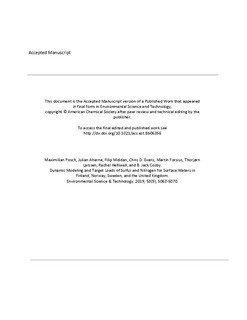| dc.contributor.author | Posch, Maximilian | |
| dc.contributor.author | Aherne, Julian | |
| dc.contributor.author | Moldan, Filip | |
| dc.contributor.author | Evans, Chris D. | |
| dc.contributor.author | Forsius, Martin | |
| dc.contributor.author | Larssen, Thorjørn | |
| dc.contributor.author | Helliwell, Rachel C. | |
| dc.contributor.author | Cosby, B Jack | |
| dc.date.accessioned | 2020-02-04T07:31:26Z | |
| dc.date.available | 2020-02-04T07:31:26Z | |
| dc.date.created | 2019-07-21T16:09:59Z | |
| dc.date.issued | 2019 | |
| dc.identifier.citation | Environmental Science and Technology. 2019, 53 (9), 5062-5070. | nb_NO |
| dc.identifier.issn | 0013-936X | |
| dc.identifier.uri | http://hdl.handle.net/11250/2639430 | |
| dc.description | Embargo until 29 March 2020 | nb_NO |
| dc.description.abstract | The target load concept is an extension of the critical load concept of air pollution inputs to ecosystems. The advantage of target loads over critical loads is that one can define the deposition and the point in time (target year) when the critical (chemical) limit is no longer violated. This information on the timing of recovery requires dynamic modeling. Using a well-documented dynamic model, target loads for acidic deposition were determined for 848 surface waters across Finland, Norway, Sweden, and the United Kingdom for the target year 2050. In the majority of sites (n = 675), the critical ANC-limit was predicted to be achieved by 2050; however, for 127 sites, target loads were determined. In addition, 46 sites were infeasible, i.e., even a reduction of anthropogenic deposition to zero would not achieve the limit by 2050. The average maximum target load for sulfur was 38% lower than the respective critical load across the study lakes (n = 127). Target loads on a large regional scale can inform effects-based emission reduction policies; the current assessment suggests that reductions beyond the Gothenburg Protocol are required to ensure surface water recovery from acidification by 2050. | nb_NO |
| dc.language.iso | eng | nb_NO |
| dc.publisher | American Chemical Society | nb_NO |
| dc.title | Dynamic Modeling and Target Loads of Sulfur and Nitrogen for Surface Waters in Finland, Norway, Sweden, and the United Kingdom | nb_NO |
| dc.type | Journal article | nb_NO |
| dc.type | Peer reviewed | nb_NO |
| dc.description.version | acceptedVersion | nb_NO |
| dc.source.pagenumber | 5062-5070 | nb_NO |
| dc.source.volume | 53 | nb_NO |
| dc.source.journal | Environmental Science and Technology | nb_NO |
| dc.source.issue | 9 | nb_NO |
| dc.identifier.doi | 10.1021/acs.est.8b06356 | |
| dc.identifier.cristin | 1712224 | |
| cristin.unitcode | 7464,30,0,0 | |
| cristin.unitname | Fagsenter for ferskvannsmiljø | |
| cristin.ispublished | true | |
| cristin.fulltext | postprint | |
| cristin.qualitycode | 2 | |
